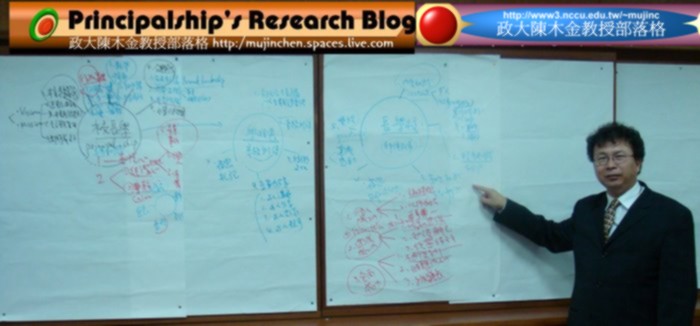2.教育領導者的風格研究
校長是學校教育的重要推手,也是學校發展的領航者,其領導是否得法關係著學校行政與教學的成敗,因此校長的素質與表現相當重要(謝文全,1999)。陳木金(2004)指出,許多校長學的研究顯示,校長的領導方式對於學校組織氣候、教師組織承諾、學校變革的能力具有影響力,對於學生學習成就更有正向的影響。吳清基(2005)指出,盱衡世界眾多先進國家,在推動教育改革的作為上,大多致力於建構卓越學校教育之相關指標,並拔擢辦學績優的學校,繼而宣導推廣,作為其他學校觀摩學習之標竿。陳木金(2007)指出,當今的學校領導者若能發展出洞察存在於雜亂現象之內潛藏的規律秩序結構,發展出「力的性質」,吸引系統裡的各個元素,進而啟動運作「混沌系統」,會發展產出更美好的結果,作為從學校行政管理系統知識的圖像建構,找出信念系統、人的系統、組織系統、溝通系統及行動系統的學校經營知識,建構學校行政管理的專業發展。綜合上述學者專家之論述、國外相關案例以及臺北市優質學校之推動經驗,「今日的領導者,明日的世界;有怎樣的校長,就有怎樣的學校。」學校的現場生活充滿著喜樂煩憂,校長在學校經營的成效扮演著關鍵的角色,因此其領導風格也深深地影響學校效能的發展。以下,我們在本週將探討領導者風格的相關研究。例如,在「Mind Tools - Essential Skills for an Excellent Career!」的網站之專文「Leadership styles:Using the right one for your situation」,有以下的相關介紹,值得深入探討:
From Mahatma Gandhi to Jack Welch and Martin Luther King to Rudolph Giuliani, there are as many leadership styles as there are leaders. Fortunately, business people and psychologists have developed useful, shorthand ways of describing the main leadership styles that can help aspiring leaders to understand and adapt their own styles and leadership impact.
The leadership styles we look at here are:
Autocratic leadership
Bureaucratic leadership
Charismatic leadership
Democratic leadership or Participative leadership
Laissez-faire leadership
People-oriented leadership or Relations-Oriented leadership
Servant leadership
Task-oriented leadership
Transactional leadership
Transformational leadership
Refer from: http://www.mindtools.com/pages/article/newLDR_84.htm
Link to:
☆張永欽(民90):台北市立國小校長領導行為塑造學校組織文化與學校效能之研究
2-1.Principals Identify Top Ten Leadership Traits
2-2.Mistakes Educational Leaders Make
2-3.National Association of Secondary School Principals( NASSP) has assembled three task forces charged with addressing issues that impact middle level and high schools in the areas of NCLB reauthorization, principal preparation, and urban education.
2-4.Trends and Issues: Leadership Skills, Styles, and Prerequisites
2-5.Leadership styles: Using the right one for your situation
***領導專書閱讀文章: 《孫子兵法》作戰篇第二
孫子曰:凡用兵之法,馳車千駟,革車千乘,帶甲十萬,千里饋糧,則內外之費,賓客之用,膠漆之材,車甲之奉,日費千金,然后十萬之師舉矣。其用戰也貴勝,久則鈍兵挫銳,攻城則力屈,久暴師則國用不足。夫鈍兵挫銳,屈力殫貨,則諸侯乘其弊而起,雖有智者,不能善其后矣。故兵聞拙速,未睹巧之久也。夫兵久而國利者,未之有也。故不盡知用兵之害者,則不能盡知用兵之利也。
善用兵者,役不再籍,糧不三載﹔取用于國,因糧于敵,故軍食可足也。
國之貧于師者遠輸,遠輸則百姓貧。近師者貴賣,貴賣則百姓竭,財竭則急於丘役。力屈、財殫,中原內虛于家。百姓之費,十去其七﹔公家之費:破軍罷馬,甲冑矢弩,戟盾蔽櫓,丘牛大車,十去其六。
故智將務食于敵。食敵一鐘,當吾二十鐘﹔箕桿一石,當吾二十石。
故殺敵者,怒也﹔取敵之利者,貨也。故車戰,得車十乘已上,賞其先得者,而更其旌旗,車雜而乘之,卒善而養之,是謂勝敵而益強。
故兵貴勝,不貴久。
故知兵之將,民之司命,國家安危之主也。
2009年3月5日 星期四
訂閱:
張貼留言 (Atom)


沒有留言:
張貼留言